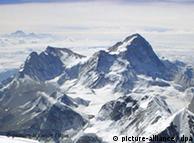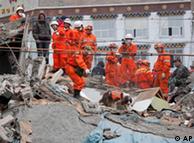Quakes will affect East Asia for millions of years
The reason for the recurring quakes in the Indo-Chinese region lies far beneath the earth's surface. About 50 million years ago, the Indo-Australian plate collided with the Eurasian plate, forming the orogenic belt that created the Tibetan Plateau and the Himalayan Mountains.
The Indo-Australian plate is currently moving faster than the Eurasian plate, which is causing the latter to deform and the former to compress. Every year, the Indo-Australian plate thrusts into the Eurasian plate by about five or six centimeters. The plates collide in a frontal way, which is why this region has been prone to earthquakes for millions of years.
"The earth is moving constantly," says Rainer Kind from the German Research Centre for Geosciences in Potsdam. He compares the dynamics in the center of the earth with the movements in a hot cooking pot: "The source of warmth moves from the bottom of the pot to the top – the heat rises to the earth's surface." And the tectonic plates are moved by the rising heat. Bildunterschrift: Großansicht des Bildes mit der Bildunterschrift: The Himalayas were created when two tectonic plates collided
Bildunterschrift: Großansicht des Bildes mit der Bildunterschrift: The Himalayas were created when two tectonic plates collided
Crustal material pushes up like toothpaste
The Himalayas, which came as a result of sedimentary rocks after the collision, rise by about 5 mm a year and are geologically active.
The 5,000 meter high Tibetan Plateau also came about from this collision of plates under which "extraordinary forces" move, says Rainer Kind.
The constant tension provides the driving force behind the movements of the tectonic plates and the reason for the recurring earthquakes in the eastern part of Asia. Kind likens the crustal material being pushed up and escaping in the direction of the Pacific Ocean to toothpaste being squeezed out of a tube.
Usually it is not so problematic because "the Tibet earthquakes occur in relatively unpopulated areas," Kind says. However, this week's devastating quake occurred in the populated area of Jiegu in Qinghai province, causing hundreds of deaths and making thousands homeless.
Unfortunately, however, there is no respite in sight for the East Asian region. Kind says "it will go on for several million years." However, the geoscientist does add that quakes rarely occur in the same place twice.
Author: Olja Ebel / act
Editor: Disha Uppal

沒有留言:
張貼留言